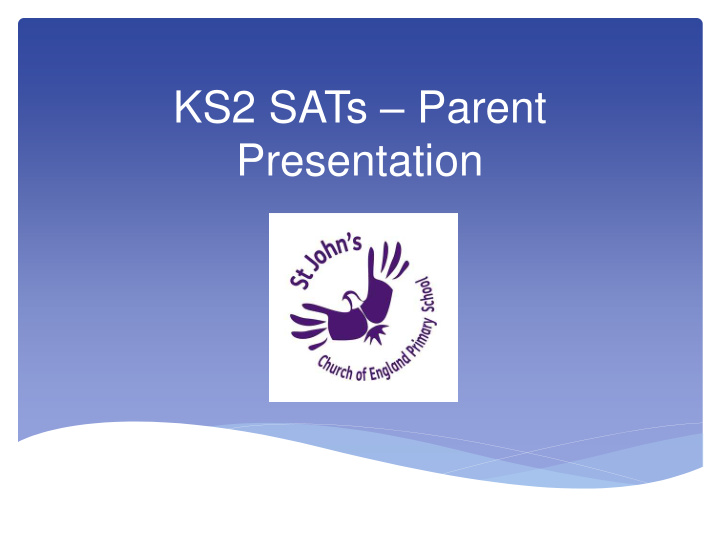



KS2 SATs – Parent Presentation
Key Stage 2 SATs Changes • In 2014/15 a new national curriculum framework was introduced by the government for Years 1, 3, 4 and 5. • However, Years 2 and 6 (due to statutory testing) continued to study the previous curriculum for one further year. • Since 2015/16 children in all years at Key Stage 1 and 2 have been expected to study the new national curriculum. • KS1 (Year 2) and KS2 SATs (Year 6) have reflected the new curriculum since 2016. • If your child is in Year 6 this year, they will receive the new tests and the new style of reporting results that were introduced in 2016.
Assessment and Reporting • ‘Old’ national curriculum levels (e.g. Level 3, 4, 5) have now been abolished, as set out in the government guidelines. • Since 2016, test scores have been reported as ‘scaled scores’. • This means it is very difficult to compare the current assessments with any earlier years. • Your child will still be taught with the highest expectations and cover all required elements of the curriculum, similar to previous years. • The new curriculum is more rigorous and sets noticeably higher expectations, which all schools have had to work hard to meet and adapt to since its introduction.
Scaled Scores • What is meant by ‘scaled scores’? • It is planned that 100 will always represent the ‘national standard’. • Each pupil’s raw test score will therefore be converted into a score on the scale, either at, above or below 100. • The scale will have a lower end point somewhere below 100 and an upper end point above 100. • A child who achieves the ‘national standard’ (a score of 100) will be judged to have demonstrated sufficient knowledge in the areas assessed by the tests. • Since July 2016 for the first publication of test results, each pupil now receives: o A raw score (number of raw marks awarded). o A scaled score in each tested subject. o Confirmation of whether or not they attained the national standard.
Scaled Score Examples On publication of the test results in July: • A child awarded a scaled score of 100 is judged to have met the ‘national standard’ in the area judged by the test. • A child awarded a scaled score of more than 100 is judged to have exceeded the national standard and demonstrated a higher than expected knowledge of the curriculum for their age. • A child awarded a scaled score of less than 100 is judged to have not yet met the national standard and performed below expectation for their age.
Higher Attaining Pupils • Previous Key Stage 2 tests were aimed at children achieving Levels 3-5 (with a national expectation to reach at least Level 4) • In the past, additional Level 6 tests were produced for children who demonstrated higher than expected attainment, above Level 5. • Under the new system, there are not any separate tests for the most able children. • Instead, each test will have scope for higher attaining pupils to show their strengths. • This means that some questions towards the end of the tests may be more difficult for many children but they should be encouraged to attempt as much of the test as they are able to.
The Tests Key Stage 2 SATs take place nationally in the week commencing 8th May 2017. • There are no tests to be administered in Science this year. • All tests are externally marked. •Writing will be ‘Teacher Assessed’ internally, as in recent years.
Reading • The Reading Test consists of a single test paper with three unrelated reading texts. • Children are given 60 minutes in total, which includes reading the texts and answering the questions. • A total of 50 marks are available. • Questions are designed to assess the comprehension and understanding of a child’s reading. • Some questions are multiple choice or selected response, others require short answers and some require an extended response or explanation.
Spelling, Punctuation and Grammar • A Spelling test is administered containing 20 words, lasting approximately 15 minutes. • A separate test is given on Punctuation, Vocabulary and Grammar • This test lasts for 45 minutes and requires short answer questions, including some multiple choice. • Marks for these two tests are added together to give a total for Spelling, Punctuation and Grammar.
Sample Questions Grammar, Punctuation and Spelling Paper 1 Gramma mar, r, Punctu tuation ation and Spelli ling g Paper r 1
Mathematics • The Mathematics tests have undergone the biggest change in recent years. • Children will sit three tests: Paper 1, Paper 2 and Paper 3. • Paper 1 is for ‘Arithmetic’ lasting for 30 minutes, covering calculation methods for all operations, including use of fractions, percentages and decimals. • Questions gradually increase in difficulty. Not all children will be expected to access some of the more difficult questions later in the paper. • Papers 2 and 3 cover ‘Problem Solving and Reasoning’, each lasting for 40 minutes. • Pupils will still require calculation skills but will need to answer questions in context and decide what is required to find a solution.
Sample Questions Maths Paper 1: Arithmetic
Sample Questions Maths Paper 2 / Paper 3 : Reasoning
Sample Questions Maths Paper 2 / Paper 3 : Reasoning
How can I help my child at home? Reading Writing Maths
Questions? Thank you for coming!
Recommend
More recommend